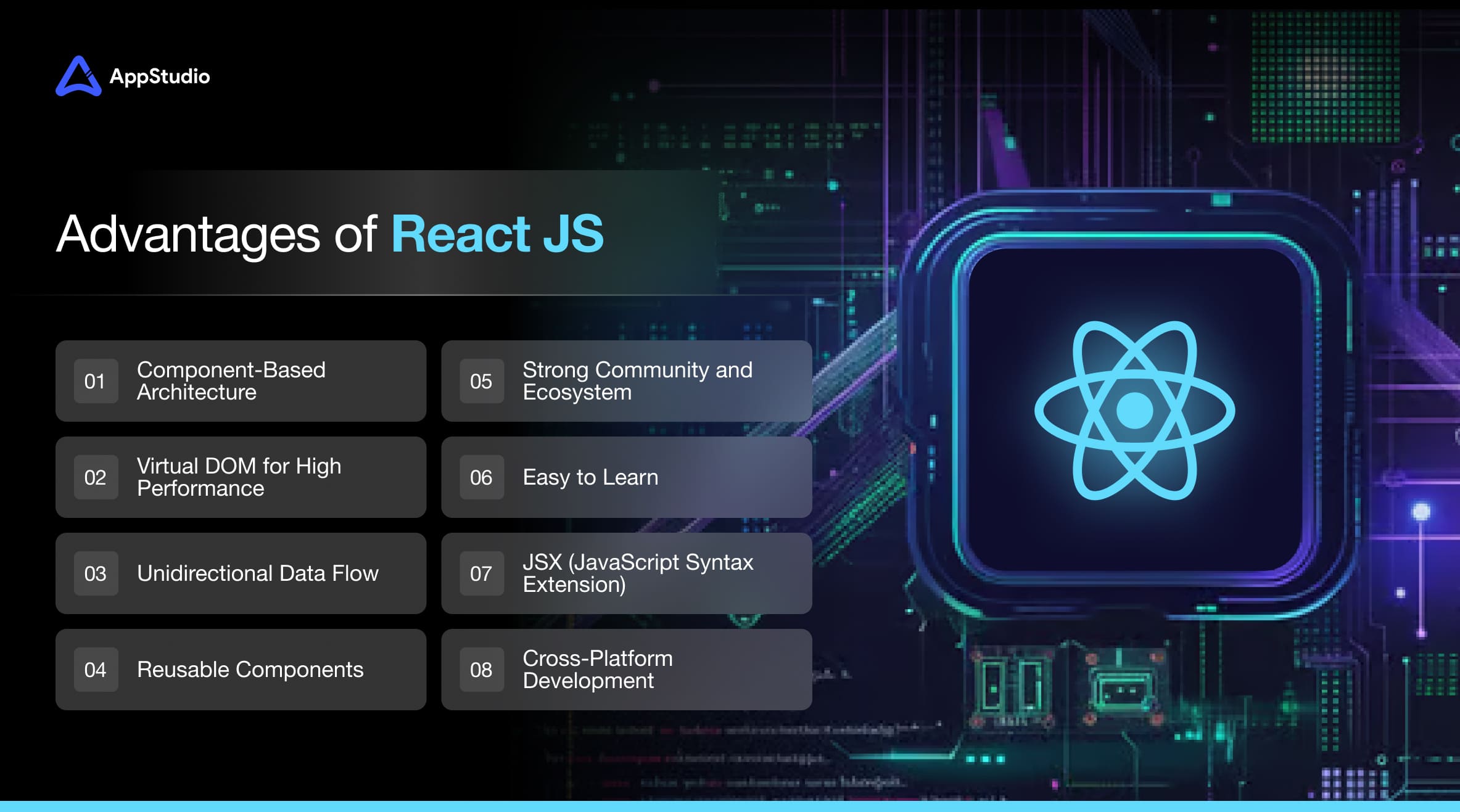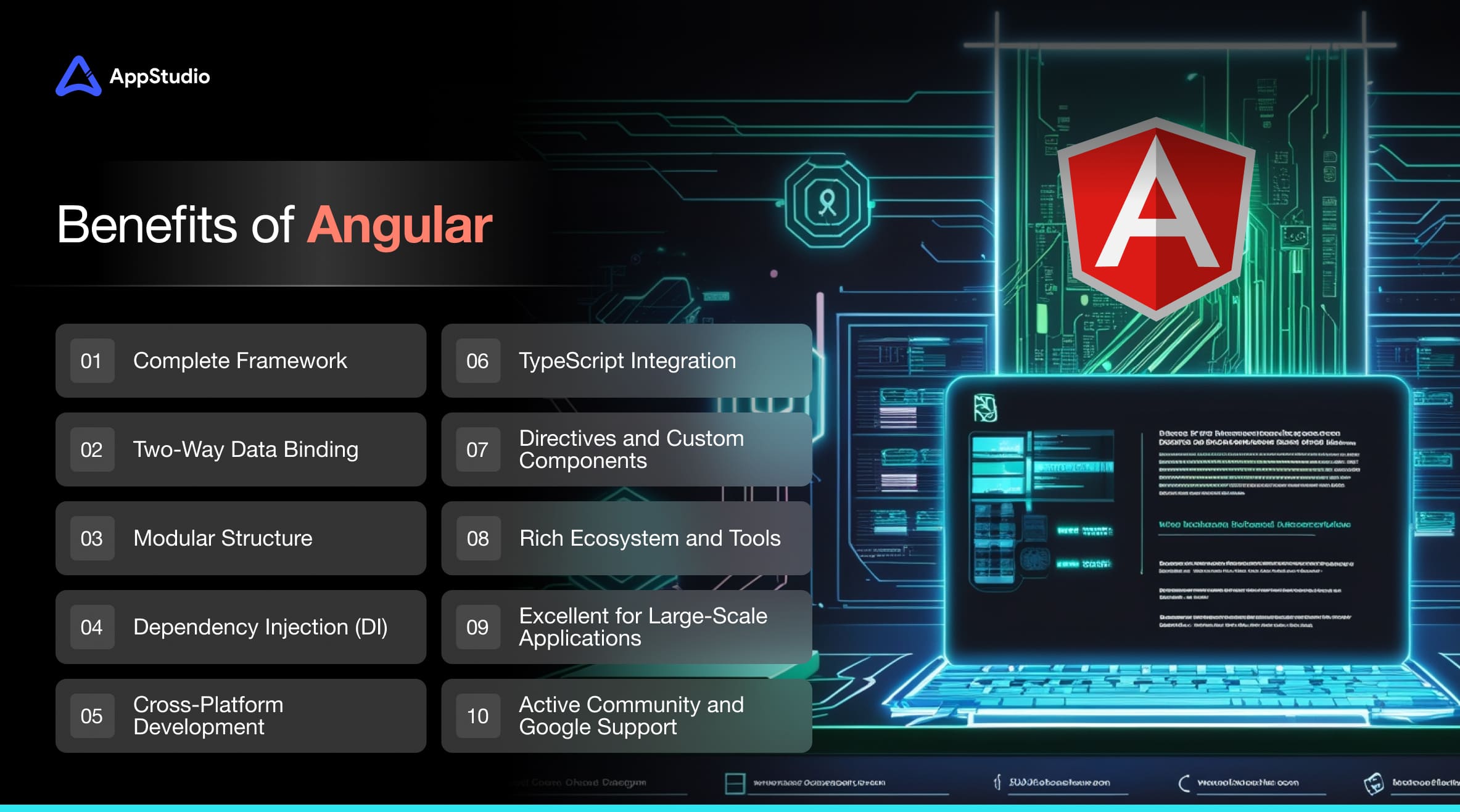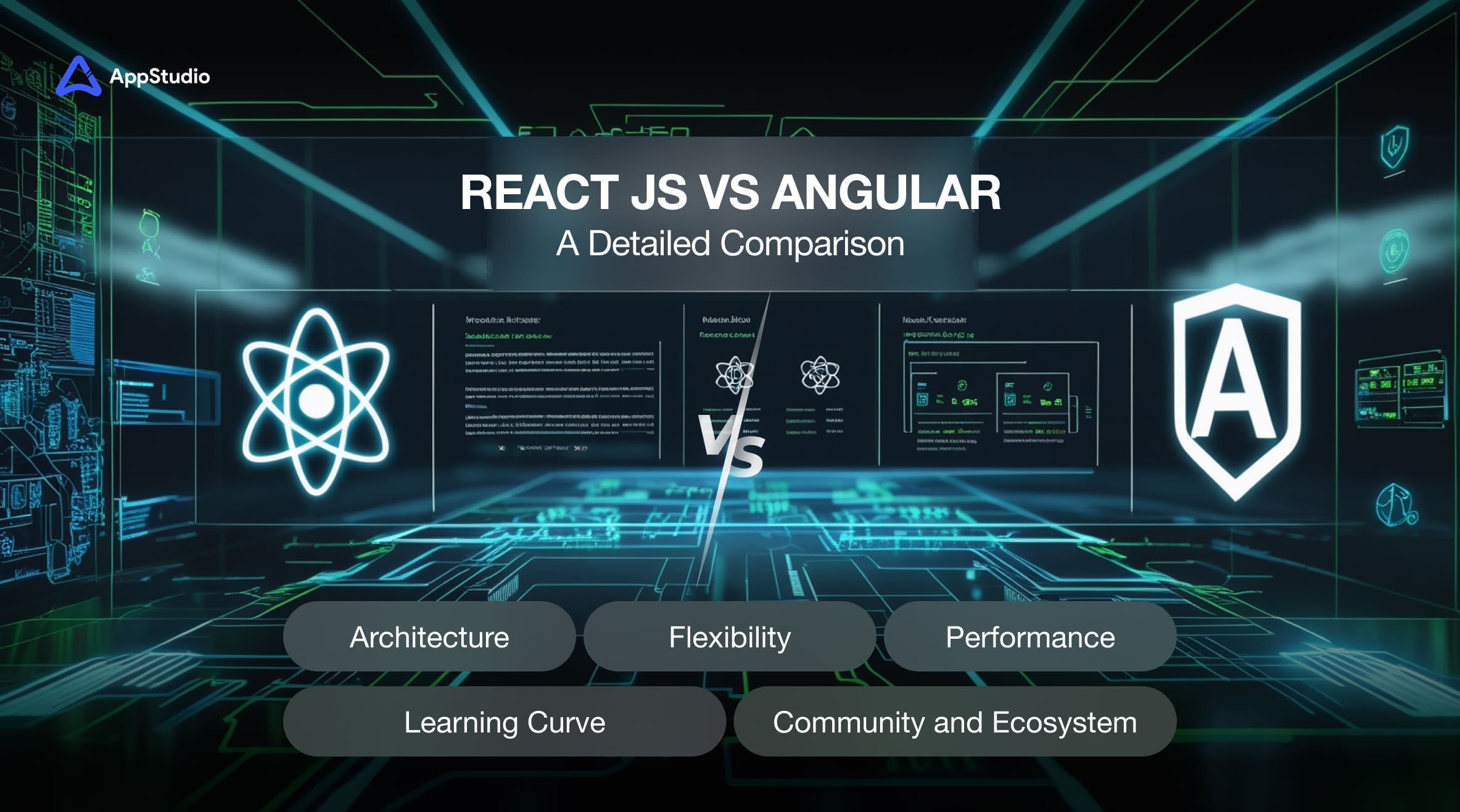In the ever-evolving world of frontend development, the choice of a framework or library can significantly impact the performance, scalability, and overall experience of building web applications. Among the most popular technologies used today are Angular and ReactJS, both of which have their unique advantages and disadvantages. But when it comes to choosing the best framework for your next project, Angular vs ReactJS becomes a key debate for developers. Let’s dive into the Angular and React JS difference and help you decide which one is right for you in 2025.
What is React?
React is an open-source JavaScript library developed by Facebook for building user interfaces, primarily for single-page applications (SPAs) where you need a fast, interactive, and dynamic web experience. React allows developers to create large web applications that can update and render efficiently in response to data changes without reloading the page. It uses a component-based architecture, meaning the UI is divided into smaller, reusable components, making it easier to manage and update.
React employs a virtual DOM (Document Object Model) that optimizes updates to the actual DOM, resulting in better performance and a smoother user experience.
Related reading: What Is ReactJS? – A Complete Guide
Advantages of React JS

1. Component-Based Architecture:
React breaks down the UI into independent, reusable components. Each component manages its state, making the development process more modular, manageable, and scalable.
2. Virtual DOM for High Performance:
React uses a virtual DOM to efficiently update the UI by minimizing changes to the real DOM, making applications faster and more responsive, especially for complex user interfaces.
3. Unidirectional Data Flow:
React follows a one-way data flow where data is passed down from parent components to child components through props. This makes the flow of data predictable and easier to debug.
4. Reusable Components:
Components in React are highly reusable. You can write a component once and use it across different parts of your application, reducing code duplication and improving maintainability.
5. Strong Community and Ecosystem:
React has a large and active community that continually contributes to its ecosystem. There are a wealth of tools, libraries, and resources available to extend React’s capabilities.
6. Easy to Learn:
With its simple and declarative syntax, React is easier to pick up compared to many other frontend frameworks. JavaScript developers, especially, can quickly understand and integrate React into their projects.
7. JSX (JavaScript Syntax Extension):
React uses JSX, which allows developers to write HTML-like syntax directly in their JavaScript code. This makes it easier to visualize the structure of components and improves readability.
8. Cross-Platform Development:
With tools like React Native, developers can write iOS and Android mobile applications using the same React principles and codebase, which can save time and resources.
What is Angular?
Angular is a comprehensive, open-source framework developed by Google for building dynamic, single-page web applications. Unlike React, which is a library primarily focused on the view layer, Angular provides a full solution for building large-scale applications, including tools for routing, state management, forms, HTTP requests, and more. It is built using TypeScript, a statically typed superset of JavaScript, which adds type safety and other features to improve the development process.
Angular follows the MVC (Model-View-Controller) architecture and supports two-way data binding, which makes it easier to keep the model and view in sync.
Related reading: React vs React Native – Difference, Features, Advantages
Benefits of Angular

1. Complete Framework:
Angular is a complete, full-fledged framework that comes with everything you need to build web applications out of the box. It provides solutions for routing, state management, forms, HTTP services, and more, which eliminates the need for additional libraries.
2. Two-Way Data Binding:
Angular’s two-way data binding allows synchronization between the model and the view. When data in the model changes, the view updates automatically, and vice versa. This makes it easier to manage data flow in large applications.
3. Modular Structure:
Angular provides a modular architecture, allowing developers to divide the application into reusable modules and components. This promotes cleaner code and easier maintenance.
4. Dependency Injection (DI):
Angular has built-in dependency injection, which makes it easy to manage the lifecycle of services and components. DI improves testability and maintainability by making dependencies explicit and decoupling components from each other.
5. TypeScript Integration:
Angular is built with TypeScript, which brings features like static typing, interfaces, and advanced object-oriented programming features. TypeScript helps developers write more maintainable and error-free code.
6. Directives and Custom Components:
Angular’s use of directives allows developers to extend HTML’s capabilities. Custom directives can be created for reusable UI elements, while custom components help in building more complex UIs.
7. Rich Ecosystem and Tools:
Angular provides a rich ecosystem of tools and libraries. It comes with a powerful CLI (Command Line Interface) for generating components, services, and other code templates, and it integrates well with testing frameworks like Jasmine and Karma.
8. Excellent for Large-Scale Applications:
Angular’s structure and tooling are designed for building large, complex applications with numerous components and modules. It is well-suited for enterprise-level applications that require scalability, maintainability, and performance.
9. Cross-Platform Development:
Angular supports the development of progressive web apps (PWAs), mobile applications through Ionic, and desktop applications using Electron.
10. Active Community and Google Support:
Angular is backed by Google, which ensures ongoing updates, robust features, and enterprise support. The large Angular community contributes to an abundance of resources, tutorials, and third-party tools.
What is the Difference Between Angular and React JS?
Before we dive into the comparison of Angular vs ReactJS, it’s essential to understand what each technology brings to the table.
- Angular: A comprehensive, full-fledged framework developed by Google, Angular is known for its robust, opinionated structure. It provides an entire ecosystem, including tools for testing, routing, forms, and HTTP services.
- ReactJS: React, developed by Facebook, is more of a library than a full-fledged framework. It focuses primarily on the view layer, allowing developers to build highly interactive UIs with its component-based architecture. However, React leaves a lot of the development decisions, such as routing and state management, up to the developer.
Related reading: Top 8 Reasons to Opt for React.js in Mobile App Development
Angular vs React JS: A Detailed Comparison

1. Architecture
One of the major Angular and React JS differences lies in their architecture. Angular is a full framework, meaning it comes with everything you need out of the box. It follows an MVC (Model-View-Controller) architecture, providing tools for all aspects of application development.
ReactJS, on the other hand, is just a view library. While it excels at handling the UI layer, it leaves much of the rest of the architecture to other libraries (like Redux for state management or React Router for navigation). This difference between Angular and React JS allows ReactJS to be more lightweight but may require additional libraries to complete a project.
2. Learning Curve
When comparing Angular vs React front end, Angular has a steeper learning curve. This is because Angular is a comprehensive framework that requires understanding TypeScript, RxJS, and Angular’s various services and modules. For a developer already familiar with JavaScript, the difference between Angular and React JS in terms of learning curve is significant.
ReactJS, however, has a much simpler API and is easier for beginners to grasp, especially if they already have experience with JavaScript. The angular vs reactjs learning curve is less steep with React, making it a popular choice for developers who are just getting started with frontend development.
3. Performance
When it comes to performance, both Angular and React are highly optimized, but they have different approaches.
- React uses a virtual DOM to update the UI efficiently. This allows React to minimize the number of updates to the real DOM, resulting in faster performance.
- Angular, while optimized, directly manipulates the real DOM. This can lead to slower updates in complex applications, although Angular’s change detection mechanism helps to improve performance in many cases.
The angular vs reactjs performance comparison will often depend on the complexity of the project. For highly dynamic applications, React may offer better performance, especially as it optimizes rendering through its virtual DOM.
4. Flexibility
In terms of flexibility, ReactJS is the winner. React allows developers to structure their applications however they want. It’s very modular and lets you mix and match libraries based on your needs. This flexibility gives you the freedom to choose tools that best suit your project.
On the other hand, Angular is a more opinionated framework. While this means that Angular provides a lot of guidance and built-in functionality, it also means that developers are more restricted in how they can structure their applications.
5. Community and Ecosystem
Both Angular vs ReactJS have large and active communities, but ReactJS has a slight edge in terms of ecosystem and adoption. React has been widely adopted for building everything from simple UIs to complex web applications, and its community offers a vast selection of third-party tools and resources.
Angular, being a full-fledged framework, offers an integrated solution, but its ecosystem tends to be more specialized for larger, enterprise-level applications. As a result, the difference between Angular and React JS when it comes to ecosystem support can be significant based on your project’s size and complexity.
Angular vs ReactJS in 2025: Which is Better?
So, which is better: Angular or ReactJS? The answer depends largely on your project’s needs and your team’s experience.
If you’re building a large-scale enterprise application, Angular may be the right choice because of its opinionated structure, built-in features, and strong TypeScript support. On the other hand, if you’re working on a dynamic, high-performance application with frequent UI updates, ReactJS is likely the better option, thanks to its flexibility and virtual DOM.
In 2025, ReactJS continues to dominate in popularity, especially for startups and smaller teams, due to its simplicity and scalability. Angular remains an excellent choice for larger applications where a more rigid structure and built-in tools are beneficial.
Related reading: React Native New Architecture Decoded
Conclusion: Angular vs ReactJS – Which One Should You Choose?
When comparing Angular vs React JS, there’s no clear winner. It ultimately depends on the specifics of your project. The angular vs reactjs debate will continue to evolve, but the choice comes down to factors like project complexity, team expertise, and scalability needs.
To recap the angular vs react front end comparison:
- Angular is ideal for enterprise-scale projects that need a full-fledged framework with a lot of built-in functionality.
- ReactJS shines in projects requiring high flexibility, modularity, and better performance with its virtual DOM.
As a developer, deciding on Angular or React JS, which is better for you comes down to your familiarity with the tools and your project’s requirements. By understanding the angular and react js difference, you can make a more informed decision about which technology to use for your next web application in 2025.
Looking for expert front-end developers ? Get in touch with AppStudio– your go-to app development partner.
Frequently Asked Questions
- Angular is a complete, opinionated framework for building large-scale web applications. It follows a comprehensive MVC (Model-View-Controller) structure, providing built-in tools like form validation, routing, and state management.
- ReactJS, while extremely flexible and scalable, might require third-party libraries to match Angular’s out-of-the-box functionality for large applications.
- Angular is often preferred for large-scale applications due to its built-in tools, structure, and scalability. It comes with many features like dependency injection, two-way data binding, and a complete routing system, which makes it easier to manage complex projects.
- ReactJS, while extremely flexible and scalable, might require third-party libraries to match Angular’s out-of-the-box functionality for large applications.
- Angular has a steeper learning curve due to its complex concepts, TypeScript usage, and comprehensive toolset. Developers need to learn its various parts like modules, directives, services, and dependency injection.
- ReactJS has a simpler learning curve, especially for those familiar with JavaScript. The main focus is on JSX (JavaScript XML), and developers can pick up React more quickly compared to Angular.
- ReactJS is generally faster for UI updates due to its virtual DOM, which efficiently re-renders only the components that need to change.
- Angular uses real DOM, which can lead to slower updates in some cases, especially for larger applications. However, Angular’s change detection mechanism and optimizations have improved its performance significantly over time.
- ReactJS has a larger community, more third-party libraries, and a bigger ecosystem. Since React is more lightweight and flexible, it has gained widespread adoption and a huge developer base.
- Angular has a solid community as well, backed by Google. While it might not be as large as React’s, it remains strong and has ample resources, especially for enterprise-level applications.
- If you’re building a large-scale, enterprise-level application with structured requirements, Angular might be a better choice due to its complete toolset and robust features.
- For projects that require flexibility, fast rendering, and an easy-to-learn framework, ReactJS would be a more suitable option. It’s also ideal if you need a high degree of customization and flexibility.





